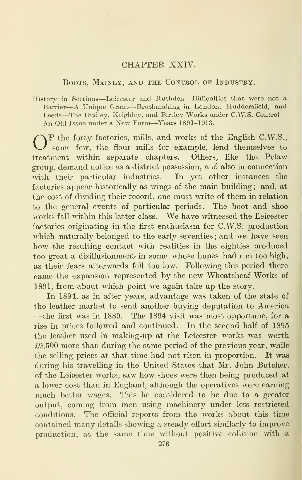Page 352 - The_story_of_the_C._W._S._The_jubilee_history_of_the_cooperative_wholesale_society,_limited._1863-1913_(IA_storyofcwsjubill00redf) (1)_Neat
P. 352
CHAPTER XXIV. — ,
Boots, Mainly, and the Control of Industry.
History in Sections—Leicester and Rushden—Difficulties that were not a
Barrier—A Unique Grant—Brushmaking in London, Huddersfield, and
Leeds—The Dudley, Keighley, and Birtley Works under C.W.S. Control
An Old Issue under a New Form—Years 1891-1913.
OF the forty factories, mills, and works of the English C.W.S.
some few, the flour mills for example, lend themselves to
treatment within separate chapters. Others, hke the Pelaw
group, demand notice as a district possession, and also in connection
with their particular mdustries. In yet other instances the
factories appear historically as wings of the main building ; and, at
the cost of dividing their record, one must write of them in relation
to the general events of particular periods. The boot and shoe
works fall within this latter class. We have witnessed the Leicester
factories originating in the first enthusiasm for C.W.S. production
which naturally belonged to the early seventies ; and we have seen
how the resulting contact with reahties in the eighties produced
too great a disillusionment in some whose hopes had run too high,
as their fears afterwards fell too low. Following this period there
came the expansion represented by the new Wheatsheaf Works of
1891, from about which point we again take up the story.
In 1894, as in after years, advantage was taken of the state of
the leather market to send another buying deputation to America
— ^the first was in 1889. The 1894 visit was most opportune, for a
rise in prices followed and continued. In the second half of 1895
the leather used in making-up at the Leicester works was worth
£9,500 more than during the same period of the previous year, while
the selling prices at that time had not risen in proportion. It was
during his traveUing in the United States that Mr. John Butcher,
of the Leicester works, saw how shoes were then being produced at
a lower cost than in England, although the operatives were earning
much better wages. This he considered to be due to a greater
output, coming from men using machinery under less restricted
conditions. The official reports from the works about this time
contained many details showing a steady effort similarly to improve
production, at the same time without positive collision -with a
276

